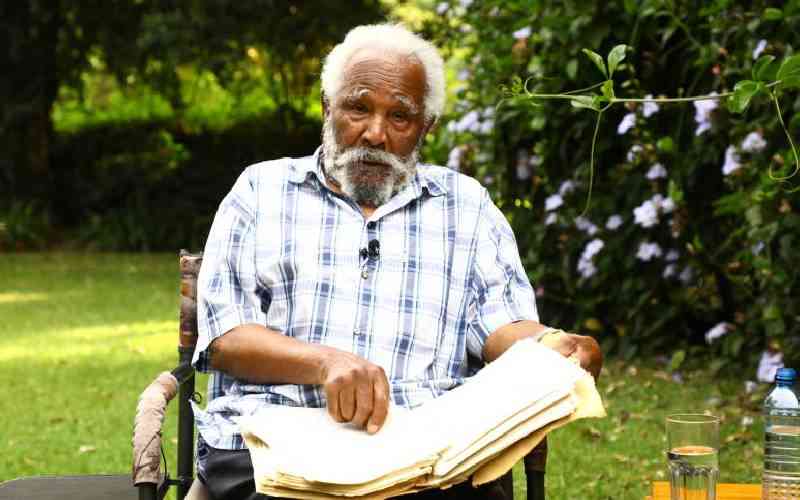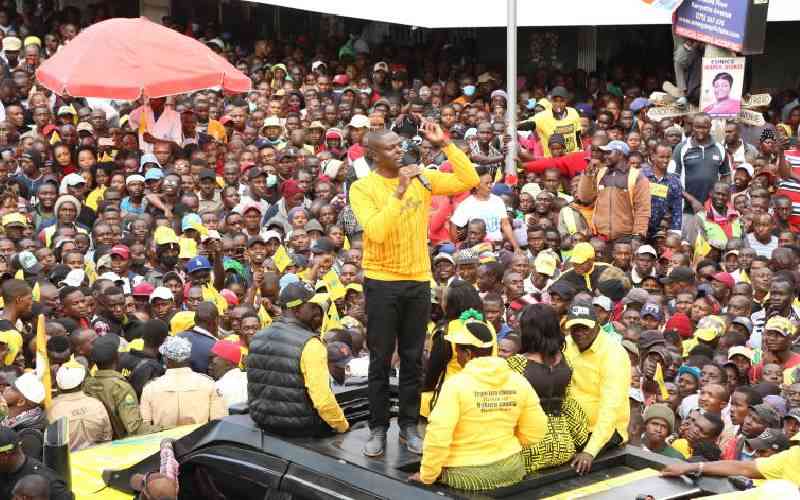By Amos Kareithi
The colonial Government had a curious way of dispensing justice, especially where its servants or loyalists were incriminated in murder.
When Chief Mundia Kuguro of Karatina and four other home guards were arrested for shooting dead Nuhu Hiuhu Kabugi, the court came to their rescue.
The court concluded the deceased had been shot during lawful patrol and it used the opportunity to commend the chief for combating Mau Mau in Karatina.
Even before analysing the evidence judge Paget Bourke concluded the chief was a victim of malice for his dedication in fighting Mau Mau in active and passive forms. |
Eric Taylor inspects rifles of the Kikuyu Guard at an early morning parade. A close check of arms and ammunition was carried out twice a day. Photo: File/Standard |
The judge also found that there was no conspiracy to kill but added there had been speculation the home guards were overzealous in killing in the belief that they would be rewarded for each person killed.
Eliminates ‘criminal’
Ironically, during the trial, one of the home guards, Kaigi Mwarari admitted in court they had killed the accused while on patrol.
The chief and Mwararia had testified in court that they shot the victim during patrol and expected to be rewarded for eliminating a criminal.
The Government disposed of the body of the alleged terrorist after none of his relatives claimed it but it was exhumed on November 3, 1955.
The body was adjudged first by the pathologist, Dr Wilkinson, who identified the accused as a Mau Mau terrorist because of the double layer of clothing. The judge believed him because this was typical of Mau Mau adherents.
Although three-eye witnesses described how the deceased had been shot, the court disbelieved them as there were discrepancies on the actual spot the body fell. And for this, the accused were discharged as the defence had planted reasonable doubts in the mind of the court.
In another peculiar case, two men were battered to death in Meru on September 13, 1954 while they were being screened.
The bodies were buried within the screening camp, which was under the area DO, a Mr Tailor but when the matter was reported to the police, the bodies were exhumed to frustrate investigations. When the police carried out exhumation in the camp, they found the graves in the screening camp empty, according to a confidential report prepared by Colonel A Young, assistant Police boss.
Stay informed. Subscribe to our newsletter
Guards against each other
"Enquiries located the bodies 33 miles away in a bush, and it emerged they had been removed on the orders of the DO," Young wrote in report dated December 10, 1954.
There was another case where home guards at Makuni post in Meru split into two and started shooting each other leading to the death of three people and wounded seven.
Police investigations were, however, halted by the area DO, Bamber, who had allegedly been instructed by the DC, because the exhibits were lost, and the suspected murders had been taken out of the camp.
Young believed all the murderers would have been arrested had the CID not been obstructed by the administration, who were only keen to recover some missing guns.
More chilling deaths were reported in Nyeri where two prisoners were removed from Kiamachibi home guard post in Nyeri and summarily shot on July 18, 1954.
When the suspected killers were arrested they all pleaded guilty, but the DC insisted a plea of not guilty be entered because they had implicated some administrators.
The CID were also outraged by the assault of Maria Wanjiku by headman Mwangi Njoroge at Kanyoni in Kiambu in October 1958, for not attending roll call while her village was under curfew.
 The Standard Group Plc is a
multi-media organization with investments in media platforms spanning newspaper
print operations, television, radio broadcasting, digital and online services. The
Standard Group is recognized as a leading multi-media house in Kenya with a key
influence in matters of national and international interest.
The Standard Group Plc is a
multi-media organization with investments in media platforms spanning newspaper
print operations, television, radio broadcasting, digital and online services. The
Standard Group is recognized as a leading multi-media house in Kenya with a key
influence in matters of national and international interest.
 The Standard Group Plc is a
multi-media organization with investments in media platforms spanning newspaper
print operations, television, radio broadcasting, digital and online services. The
Standard Group is recognized as a leading multi-media house in Kenya with a key
influence in matters of national and international interest.
The Standard Group Plc is a
multi-media organization with investments in media platforms spanning newspaper
print operations, television, radio broadcasting, digital and online services. The
Standard Group is recognized as a leading multi-media house in Kenya with a key
influence in matters of national and international interest.









